


Li Honglin
Graduate Student in Architecture, University of California, Berkeley
Currently employed at SOM San Francisco
Previously worked at OMA Netherlands – Rotterdam
EFFEKT Denmark – Copenhagen
Metrogramma Italy – Milan, etc.
Website: honglin-li.com / Instagram: honglin_li

(In the following interview, Li Honglin will be referred to as “L”)
█ In your personal profile, you mentioned that you are not only an architect but also a visualizer. Your realistic renderings are highly recognized. Can you share any insights with us? Has this realistic rendering style helped you in your job search?
L:Renderings serve as the most direct representation of architecture, and their importance cannot be overstated. Realistic renderings can be seen as the highest form of demonstrating design ability.
A good rendering can be understood from three levels: the first is the architecture itself: reflecting design details, structural understanding, and material selection. The second is the image: control over composition, color combinations, etc. The highest level is the depiction of architectural ambiance, which communicates the most emotional aspect of architecture to the audience through atmosphere. Other styles of renderings, such as line drawings or collage cartoons, can express one’s style, but the information conveyed is very limited and often not taken seriously during job applications.
Since it reflects a comprehensive ability, consciously attempting realistic renderings can significantly enhance one’s architectural design, visual aesthetics, and aesthetic accomplishments. We can also improve our understanding of composition and color matching by studying photography and appreciating master paintings, as they complement each other.
█ You have rich experience in international competitions. Can you share how you find breakthroughs or how you approach “breaking the topic”?
L:First, it is essential to analyze whether the competition is conceptual or intended for actual construction. There isn’t a one-size-fits-all logic; independent thinking and judgment are required for different projects and sites. For instance, OMA generally finds the main contradictions from local social, cultural, and economic contexts as a starting point, embodying the solution in a nearly brutal form through shape, where the form resonates with function, bringing a series of exciting spatial experiences. Sometimes this form may lead to controversy and aesthetic disagreements, but understanding the underlying logic makes one admire OMA’s strong adherence to concepts and execution.
In contrast, SOM tends to balance the architecture with the surrounding site, considering spatial practicality, utilization, economic indicators, and the energy efficiency of the facade. I often oscillate between these two endpoints, hoping to find a balance suitable for the current competition, thus developing my design logic and language. Personally, I do not agree with the notion of a design “style,” as I feel “style” is merely a lazy label for a certain design form.
█ What attracted you to participate in the competition for the Filtration Skyscraper?
L:eVolo is currently the most exposed and prestigious competition in the architecture field, attracting numerous architects and students. As a conceptual architecture competition, it is not primarily aimed at being realized or built, but rather at exploring architectural concepts and social focal issues, as well as envisioning future architecture. My initial goal in this competition was to raise awareness and discussion about plastic pollution in oceans, and only secondly to propose a relatively feasible solution.
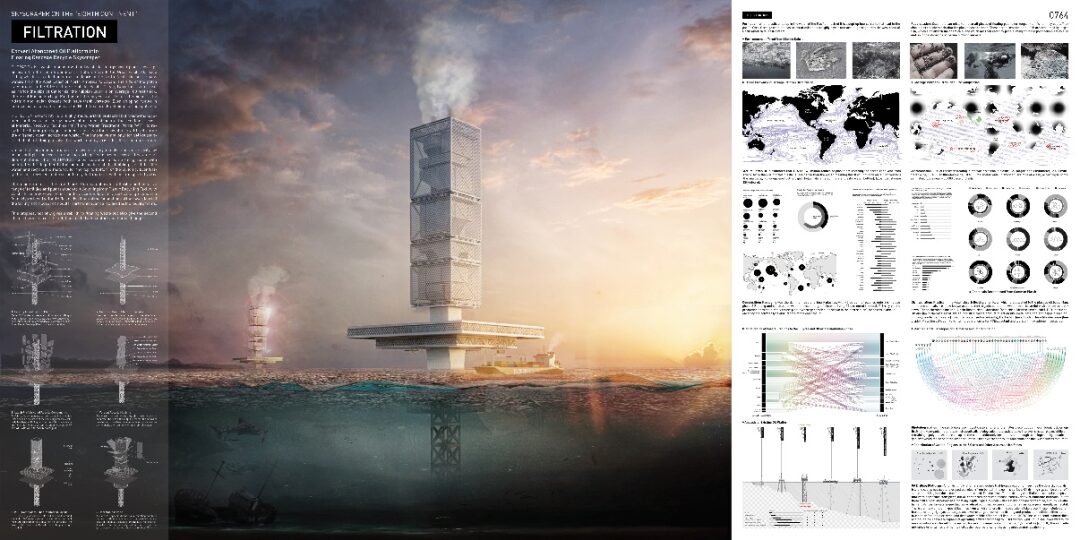
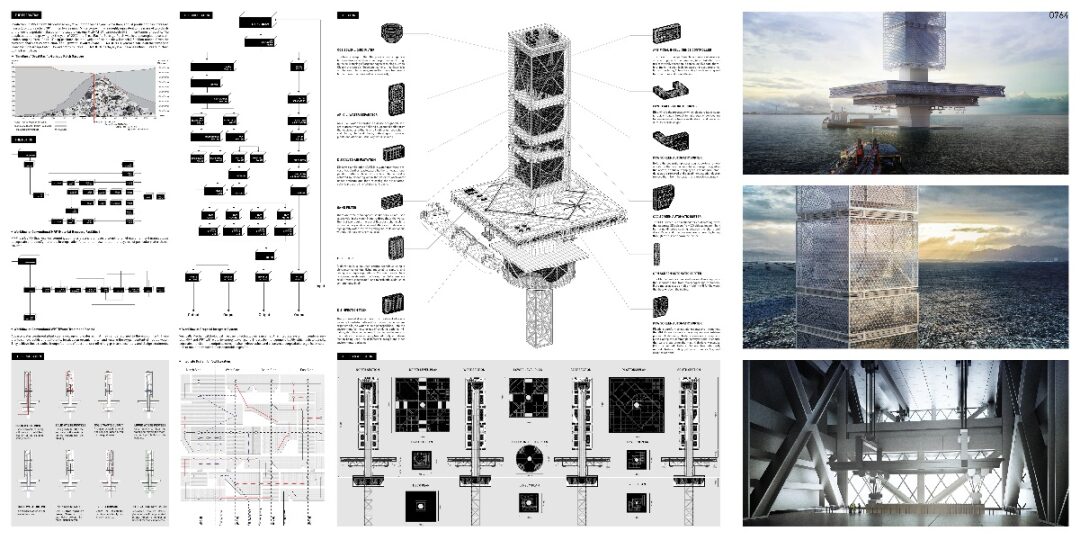
* The submission format requires two 24″ x 48″ horizontal panels each year.
█ Can you briefly introduce the design background and environment of this project?
L:The concept responds to the severe impact of plastic pollution on oceans. Due to the decline in oil prices over the past 50 years, plastic products have become cheaper and more widespread. In just two years from 2017 to 2019, the amount of plastic produced exceeded the total amount produced in the 100 years since plastic’s inception in 1917. We all know that less than 10% of plastic products in the world can be truly recycled, with the remaining 90% being incinerated, landfilled, or dumped, and most of the dumped plastic enters the oceans through waterways. These plastics follow ocean currents, ultimately gathering in five areas of stagnant and windless currents in the Pacific, Indian, and Atlantic Oceans, the largest of which is located between Hawaii and California. Currently, the area of floating debris is equivalent to the size of three Texas states or two times the area of France.
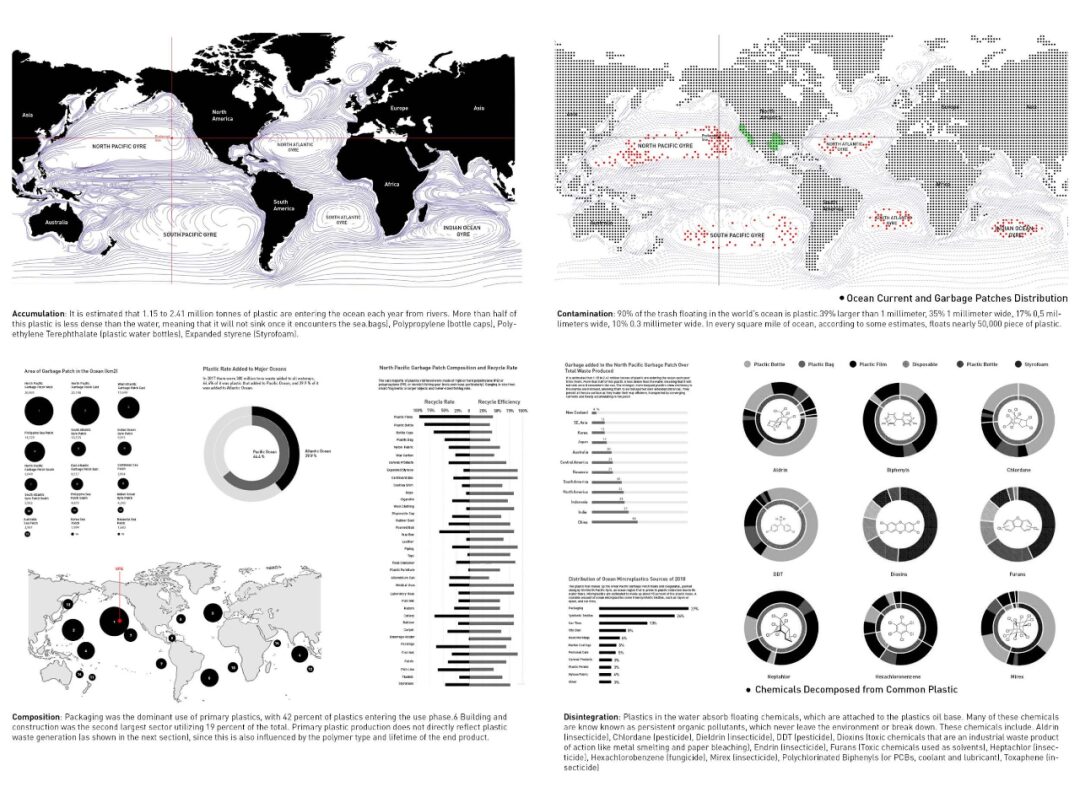
█ Can you briefly explain the overall concept, shape, structure, materials, and construction of this project?
L:This proposal envisions transforming abandoned oil drilling platforms into floating garbage recycling skyscrapers. Drilling platforms are abandoned after 10-15 years of use due to the depletion of oil in the shale beneath the seabed, and their large and sturdy structures make the dismantling process challenging, so most are left abandoned. The idea is to retain and utilize the platform’s foundational structure as much as possible, adding units for garbage collection and sorting on top, using water pumps to send seawater and garbage to the top of the building through water pressure, and then sorting, filtering, and recycling the garbage from the seawater by gravity from top to bottom. Ultimately, the purified seawater is returned to the ocean while the filtered debris is sorted and shipped away by container ships.
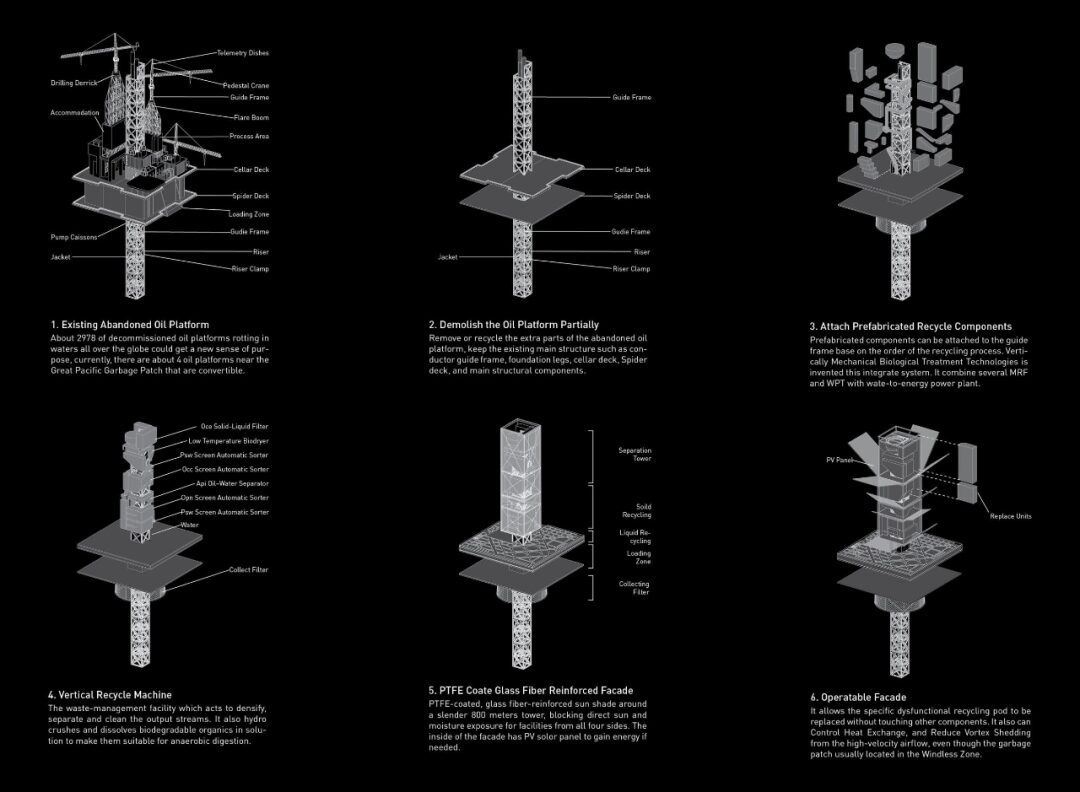
– Diagram explaining the main concept:
From the disassembly of the abandoned oil platform to the completion of the transformation, the target area is usually a dead zone for monsoons and ocean currents, thus requiring minimal consideration of wind loads on the shape. Each unit bears unique functions within the entire system, adopting prefabricated and modular construction methods for easy installation and independent replacement at sea, ensuring efficient and uninterrupted operation of the system. An ETFE (ethylene tetrafluoroethylene) skin is installed on the exterior of the recycling units to prevent corrosion of mechanical components from seawater and other natural conditions, and can be opened when necessary for heat dissipation and easy replacement and maintenance of aging units.
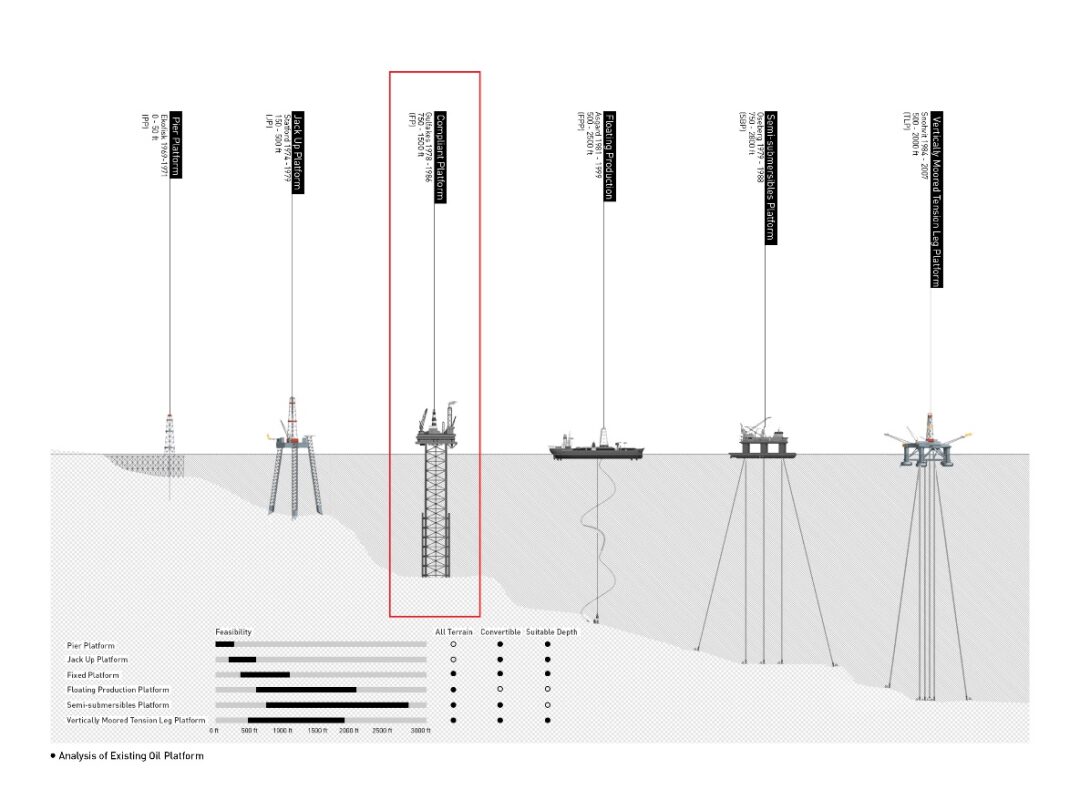
– Research on different drilling platforms:
Results indicate that the Compliant Platform type, at depths between 250 meters and 500 meters, meets the structural and foundational depth conditions for transformation.
█ Can you briefly explain the technical information and logical thinking behind these analysis diagrams?
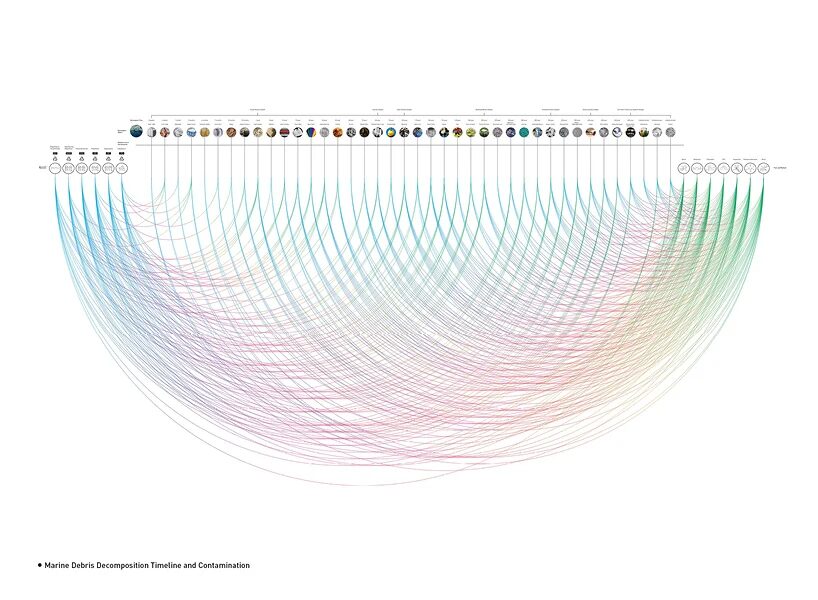
– Data visualization analysis diagram 1:
By sampling different oceanic floating plastic debris, the degradation time of various types of waste is presented graphically (for example, common plastic bottles take 150 years to fully degrade, while baby diapers take 450 years), as well as the harmful chemicals formed during decomposition over time (the left side shows potential inorganic toxins formed after waste decomposition, while the right side shows organic toxins), which are magnified through the food chain and ultimately aggregated in humans through consumed fish.
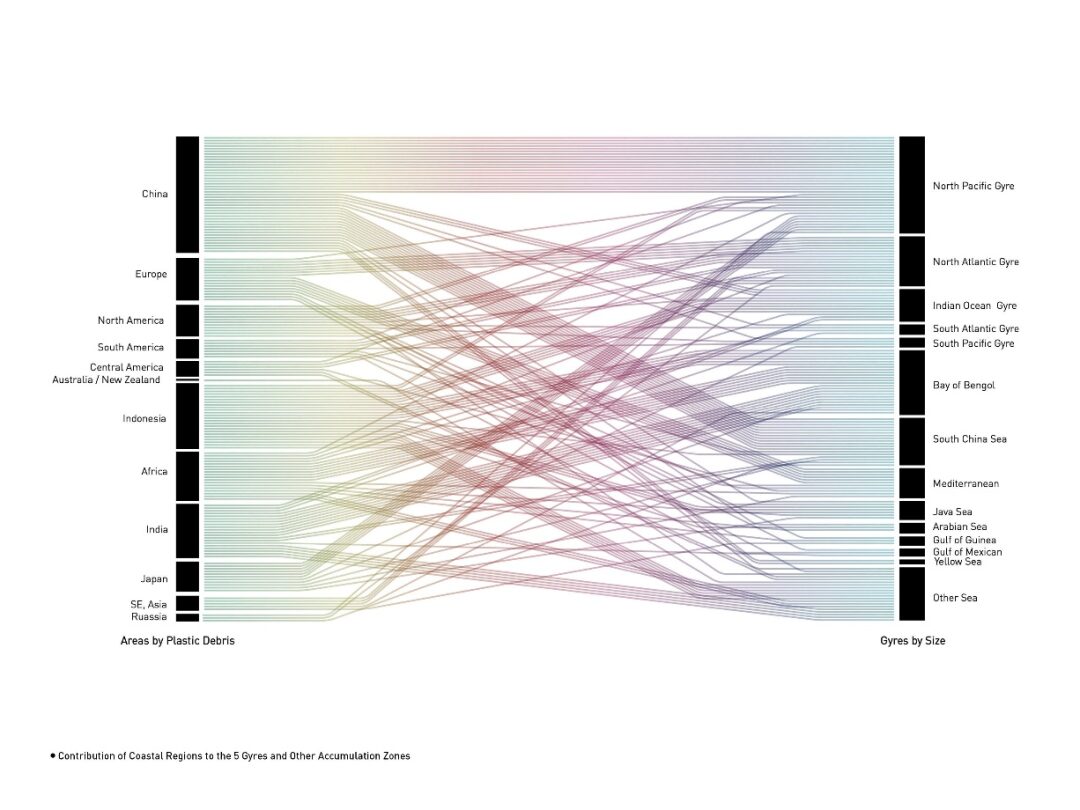
– Data visualization analysis diagram 2:
This diagram shows the total amount of waste discharged into the ocean by different countries annually and the locations where it ultimately accumulates in the oceans. For example, the waste from China primarily gathers in the North Pacific garbage patch, but some debris also follows ocean currents to the Bay of Bengal, Indian Ocean, Arabian Sea, and even the South Atlantic.
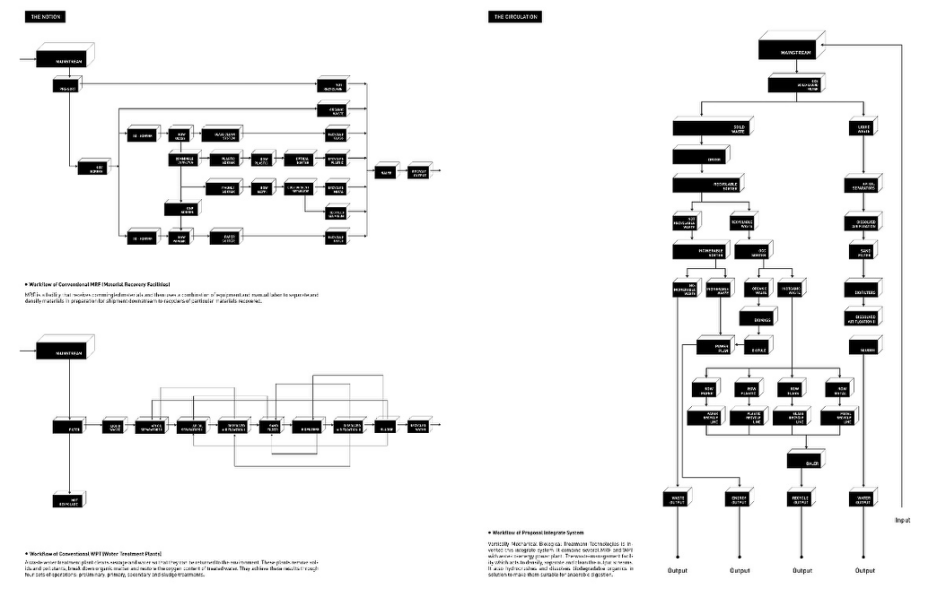
– Recycling flow and energy analysis:
By studying the various procedural steps of conventional recycling plants and wastewater treatment plants, relevant functional flows and procedures are vertically integrated to enable solid and liquid waste sorting by gravity from top to bottom. This generates recyclable materials such as paper, plastics, glass, and metals. A portion of the organic biological waste will produce electricity, biogas, or other energy types through biochemical degradation to power the building, allowing the entire system to be self-sufficient without external energy input.
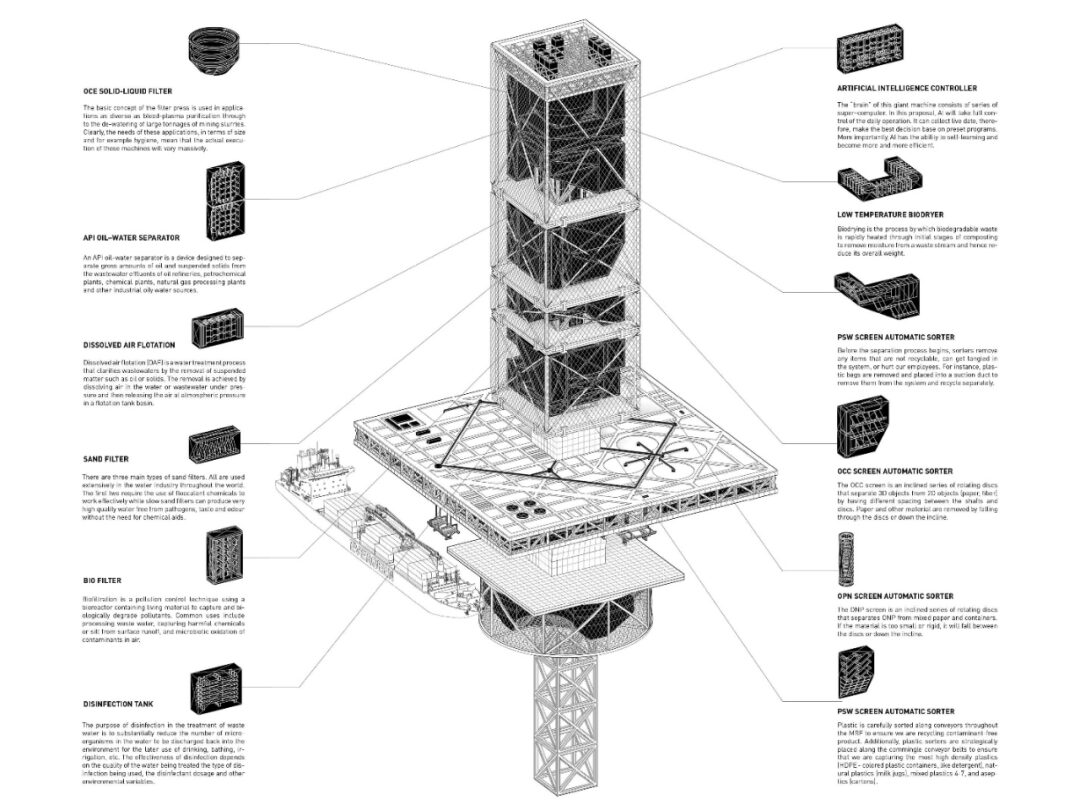
█ After the announcement of this competition, we saw various media coverage from multiple countries. Can you talk about the global impact of this project?

L:The discussion of this topic has received widespread attention from various sectors, indicating that the issue of ocean pollution has become increasingly severe today. It has been translated into Chinese, Spanish, German, Italian, and other languages, showing that countries around the world are deeply concerned about this issue. Reports and reprints regarding this project are not limited to mainstream architectural media; related citations can also be found on specialized websites in water resources and energy fields. From this perspective, the proposal has successfully achieved its design intent. Sometimes, raising awareness of a problem and providing a solution is equally important, and showcasing this design allows the public to pay more attention to this type of human crisis, providing a platform for discussion that inspires more designers and scientists to propose more realistic solutions for better resolution.
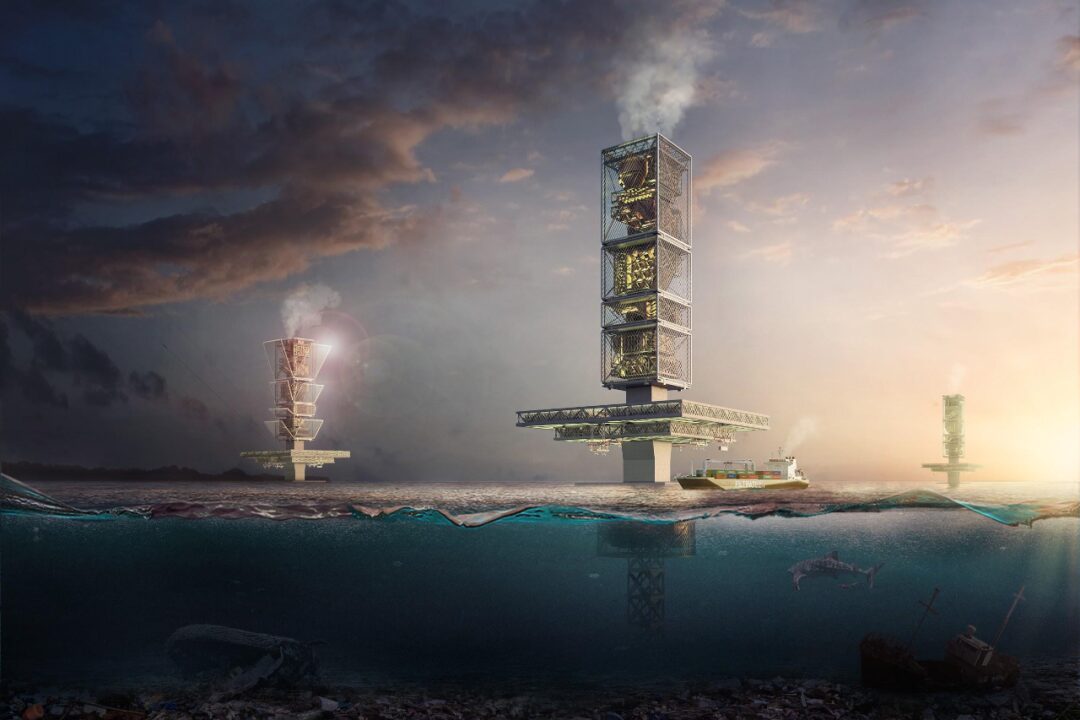
2021 eVolo International Skyscraper Design Competition
ArchiDogs Competition Enrollment Open!!
👇 Click to see details 👇



ArchiDogs Education Newly launched online courses“SuperLecture Series covering architecture, landscape, interior, urban design, and other design majors. Guest speakers for the public lectures are senior designers from top design firms, design companies, and leading design schools in the world. All course content will be grandly launched on Xiaoetong This online open course will open a new understanding of overseas design courses, marking a new chapter in your design career. Specific course content and schedules will be regularly published on the ArchiDogs WeChat official account, so please pay close attention.